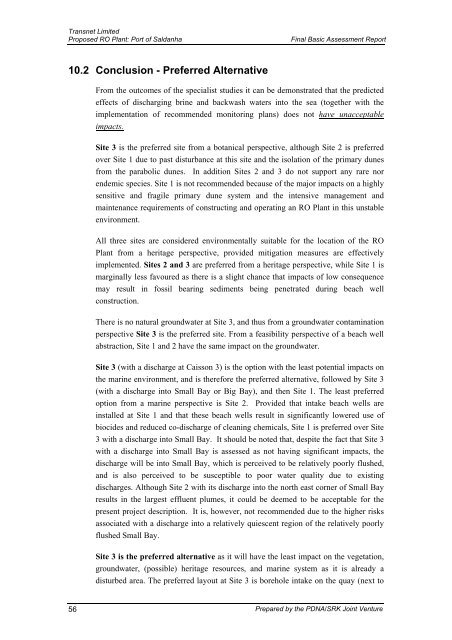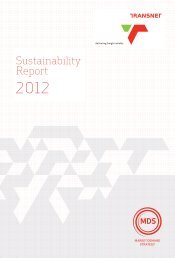Basic Assessment Report - Transnet
Basic Assessment Report - Transnet
Basic Assessment Report - Transnet
You also want an ePaper? Increase the reach of your titles
YUMPU automatically turns print PDFs into web optimized ePapers that Google loves.
<strong>Transnet</strong> LimitedProposed RO Plant: Port of SaldanhaFinal <strong>Basic</strong> <strong>Assessment</strong> <strong>Report</strong>10.2 Conclusion - Preferred AlternativeFrom the outcomes of the specialist studies it can be demonstrated that the predictedeffects of discharging brine and backwash waters into the sea (together with theimplementation of recommended monitoring plans) does not have unacceptableimpacts.Site 3 is the preferred site from a botanical perspective, although Site 2 is preferredover Site 1 due to past disturbance at this site and the isolation of the primary dunesfrom the parabolic dunes. In addition Sites 2 and 3 do not support any rare norendemic species. Site 1 is not recommended because of the major impacts on a highlysensitive and fragile primary dune system and the intensive management andmaintenance requirements of constructing and operating an RO Plant in this unstableenvironment.All three sites are considered environmentally suitable for the location of the ROPlant from a heritage perspective, provided mitigation measures are effectivelyimplemented. Sites 2 and 3 are preferred from a heritage perspective, while Site 1 ismarginally less favoured as there is a slight chance that impacts of low consequencemay result in fossil bearing sediments being penetrated during beach wellconstruction.There is no natural groundwater at Site 3, and thus from a groundwater contaminationperspective Site 3 is the preferred site. From a feasibility perspective of a beach wellabstraction, Site 1 and 2 have the same impact on the groundwater.Site 3 (with a discharge at Caisson 3) is the option with the least potential impacts onthe marine environment, and is therefore the preferred alternative, followed by Site 3(with a discharge into Small Bay or Big Bay), and then Site 1. The least preferredoption from a marine perspective is Site 2. Provided that intake beach wells areinstalled at Site 1 and that these beach wells result in significantly lowered use ofbiocides and reduced co-discharge of cleaning chemicals, Site 1 is preferred over Site3 with a discharge into Small Bay. It should be noted that, despite the fact that Site 3with a discharge into Small Bay is assessed as not having significant impacts, thedischarge will be into Small Bay, which is perceived to be relatively poorly flushed,and is also perceived to be susceptible to poor water quality due to existingdischarges. Although Site 2 with its discharge into the north east corner of Small Bayresults in the largest effluent plumes, it could be deemed to be acceptable for thepresent project description. It is, however, not recommended due to the higher risksassociated with a discharge into a relatively quiescent region of the relatively poorlyflushed Small Bay.Site 3 is the preferred alternative as it will have the least impact on the vegetation,groundwater, (possible) heritage resources, and marine system as it is already adisturbed area. The preferred layout at Site 3 is borehole intake on the quay (next to56Prepared by the PDNA/SRK Joint Venture
















